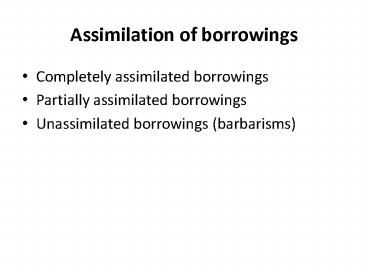Assimilation of borrowings - PowerPoint PPT Presentation
1 / 11
Title:
Assimilation of borrowings
Description:
Assimilation of borrowings Completely assimilated borrowings Partially assimilated borrowings Unassimilated borrowings (barbarisms) Completely assimilated borrowed ... – PowerPoint PPT presentation
Number of Views:217
Avg rating:3.0/5.0
Title: Assimilation of borrowings
1
Assimilation of borrowings
- Completely assimilated borrowings
- Partially assimilated borrowings
- Unassimilated borrowings (barbarisms)
2
Completely assimilated borrowed words
- follow all morphological, phonetical and
orthographic standards of the English language - E.g. cheese (the word of the first layer of
Latin borrowings), husband (Scand.), face (Fr.),
animal (the Latin word borrowed during the
revival of learning).
3
Partially assimilated borrowed words
- borrowings not completely assimilated graphically
- E.g. the final consonant is not pronounced
ballet, buffet with diacritic mark café,
cliché. Specifically French digraphs (ch, qu, ou,
etc.) bouquet, brioche.
4
Partially assimilated borrowed words
- borrowings not completely assimilated
phonetically. - E. g. the accent on the final syllable machine,
cartoon, police sounds that are not standard
for the English language ? bourgeois,
prestige, regime. - borrowings not assimilated grammatically. E. g.
crisis crises, phenomenon phenomena.
5
Partially assimilated borrowed words
- borrowings not assimilated semantically denote
- - Foreign clothing sari, sombrero
- - Foreign titles and professions shah,
rajah, toreador - - Foreign vehicles rickshaw
- - Foreign food and drinks pilau, sherbet
6
Unassimilated borrowings or barbarisms
- This group includes words from other languages
used by English people in conversation or in
writing but not assimilated in any way, and for
which there are corresponding English
equivalents. - E. g. the Italian addio, ciao (good bye), the
French coiffure (hairstyle), ennui (boredom).
7
The degree of assimilation depends on
- the time of borrowing
- frequency of use
- the way in which the borrowing was taken over
into the language (orally, through writing)
8
Etymological doublets
- Etymological doublets are two or more words
originating from the same etymological source,
but differing in phonetic shape and meaning. - E. g. shirt (Eng.) skirt (Scand.)
9
Sources of etymological doublets
- Native word borrowed word shirt (Eng.) skirt
(Scand.) shrew (Eng.) screw (Scand.) - Both words are borrowed from different languages
which are historically descended from the same
route captain (Lat.) chieftain (French) senior
(Lat.) sir (French), canal k?'næl (Lat.)
channel (French).
10
Sources of etymological doublets
- Both words are be borrowed from the same language
but in different historical periods travel
(Norman borrowing) travail (Parisian borrowing)
(puna), corpse k??ps (Norman borrowing) (trupi)
corps k?? (Parisian borrowing), hospital
(Lat.) hostel (Norman French) hotel (Parisian
French).
11
Sources of etymological doublets
- Both words are native, but one of them originates
from the other history story, phantasy
fancy, defence fence, shadow shade.































